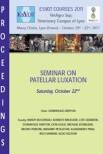This study evaluated adaptations in vertical force and temporal gait parameters to hind limb lameness in walking and trotting dogs. Eight clinically normal adult Beagles were allowed to ambulate on an instrumented treadmill at their preferred speed while the ground reaction forces were recorded for all limbs before and after a moderate, reversible, hind limb lameness was induced. At both gaits, vertical force was decreased in the ipsilateral and increased in the contralateral hind limb. While peak force increased in the ipsilateral forelimb, no changes were observed for mean force and impulse when the dogs walked or trotted. In the contralateral forelimb, the peak force was unchanged, but the mean force significantly increased during walking and trotting; vertical impulse increased only during walking. Relative stance duration increased in the ipsilateral hind limb when the dogs trotted. In the contralateral fore and hind limbs, relative stance duration increased during walking and trotting, but decreased in the ipsilateral forelimb during walking. Analysis of load redistribution and temporal gait changes during hind limb lameness showed that compensatory mechanisms were similar regardless of gait. The centre of mass consistently shifted to the contralateral body side and cranio-caudally to the side opposite the affected limb. These biomechanical changes indicate substantial short- and long-term effects of hind limb lameness on the musculoskeletal system.
Compensatory load redistribution in walking and trotting dogs with hind limb lameness.
Date
2013 Sep
Journal
Vet J
Volume
197
Number
3
Pages
746-52









